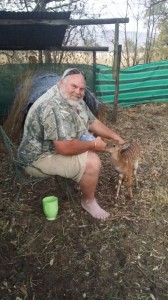Another Great African Adventure – I
 I have been planning this trip back to South Africa since I returned from my 2011 adventure with long-time buddy Roy Enter. This trip would be a bit less hunting and a bit more daily life with my friends Richard and Ruth Lemmer. This trip, I was on my own.
I have been planning this trip back to South Africa since I returned from my 2011 adventure with long-time buddy Roy Enter. This trip would be a bit less hunting and a bit more daily life with my friends Richard and Ruth Lemmer. This trip, I was on my own.
It only took a day and a half to get from Sea-Tac to O.R. Tambo International Airport at Johannesburg. Twenty-three hours on clean and comfortable Emerites Airline Boeing 777-300 aircraft, wrapped around a nine-plus hour wait in the shiny glass and steel palace known as the UAE’s Dubai International. Truth be told, with a little sleep planning, it didn’t seem all that long.
I walked into the big reception hall at Tambo, in the midst of more chattering and laughter than I ever hear in a US airport, and found Ruth waving for me.
We would have lunch, then collect Richard from the courthouse where he was arguing against a neighbor’s suit over a large motorized gate he had placed along the common property line to keep his valuable wildlife stock on his ground. The absentee landowning neighbor claimed he needed to immediately plant corn on his property (in the now-winter dry season and with no irrigation water) and would be unable to get his large combine through the gate. “Yeah,” I thought, “some arguments are universal. Welcome home.” About then, I began thinking about these South African hunting grounds less as large wildlife ranches and more as farming and ag.
Most of my ten days in the country around Mokopane (Limpopo Province, southwest of Kruger National Park) had me thinking about agriculture, and the folks who worked it, in a fresh way. One morning over breakfast, I asked Richard about writing a note in one of my Wild Winds books for the owner of the striking place we had taken blue wildebeest and poked around for a big boar warthog. “So, do I thank him for hunting his land, Richard? Or say how much I enjoyed being on his ranch, or his ground, or what?” “Farms. These are all game farms, big or small. We are farmers.” I got it; hunting on any concession – 75 acres or 60,000 acres – we were hunting someone’s farm.
The point came home to me again as I watched Richard and his friends trying to capture and move half a dozen nyala – striped mule deer size antelopes that hang out at the edges of the bush and the openings. The ewes and one bull were expensive animals sold from one farmer to another. They would have been culled as excess by one, but will now be treasured as a new herd of valuable animals on the farm of the other. First, though, they had to be coaxed into the trailer.
Trapping and moving the nyala reminded me of how we had funneled bighorns and pronghorns and elk into holding pens and then into trailers in Colorado years ago. Those were animals traded from one state to another to rebuild or reintroduce herds, and probably traded for some critter Colorado needed somewhere. This translocation stuff is pretty common in the US, although here we don’t generally consider game animals to be, in any way, private property.
Too, we never had as much drama capturing and loading sheep, pronghorns and elk as these guys did getting those nyala down the funnel – the boma. Of course, we might sometimes dart and drug them to simplify the job. By the time this job was said and done, however, half of the animals in the holding area went over the eight-foot tarp lined wall (someone had failed to tell the nyala ewes that they couldn’t jump). They may have been privately-traded stock, but they were still very wild antelope. The bull and ewe and lambs that made it into the trailer and to Richard and Ruth’s farm would be the start of a new herd. Those left behind would be collected another day – probably darted.
One ewe going over the wall left a lamb too young to fend for itself. “Anna Nyala” is being bottle fed by Richard, and is now acclimating to a small outside area. She will join the others on the farm in a few weeks.
Over and again, I experienced the connections between wildlife and domestic stock (cattle, sheep and goats) and what we might think of as farming and agriculture. The game animals are clearly wild and wary, even it they are roaming 1,000 acres within a high fence. One might argue that the only truly wild animals are the warthogs, bushpigs, jackals, monkeys, baboons and large kudu bulls which pretty much ignore the fences and go where they wish to go, but I never crossed paths with “tame” wildlife of any kind.
In so many ways, our hunting forays in Limpopo Province – the Sterk Rivier country – reminded me of hunts I’ve made my whole life in the West. A case in point would be my quest around a large cattle operation for a big boar warthog. And another warthog watch across a supplemental feeding site for cape buffalo. Those are other stories.
See you next week. Much as I loved being with my South African friends, it is good to be home.







